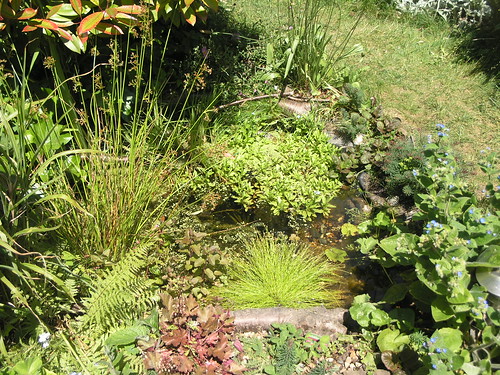
Its all go in the pond at the moment. The water forget-me-not is adding a lovely haze of tiny blue flowers that the bees and hoverflies are loving.
The reeds are covered in beautiful, wispy wind-pollinated flower tufts and provide a welcome resting place for the huge numbers of damselflies still mating and laying eggs. They also act as an essential stepladder, allowing damselfly and dragonfly nymphs to climb up out of the water and hatch into adults. That's why ponds without plants are useless for those insects to breed in.
Newly emerged damselflies and dragonflies are pale, vulnerable and unable to fly. Over the first few hours after emerging they cling to the plant stem and gradually stiffen their wings and develop their final adult colour.
Damselfly:
You can see the nymph 'shell' that these two newly emerged damselflies climbed out of. It amazes me that such a large insect can come from such a comparatively small nymph.
The left-hand picture shows a damselfly that had emerged only a few minutes before I managed to get the photo. It is squashed and pale, and the wings are longer than the thick and stumpy abdomen.
The right hand picture shows another damselfly when it was around an hour old, and you can see that the body is becoming much more long and slender, the wings are straightening and stiffening, and some colour is appearing along the abdomen and in stripes on the thorax.
Another hour or so and the insect looks much as the one below. It is becoming even more obviously marked and the distinctive shape of a damselfly is fully formed. The wings are only crumpled at the tips now.
Below is the same insect about an hour later still. The black markings are clear and well defined now, and the pale areas are starting to become noticeably blue.
Eventually, it will look as magnificent (and blue) as this fully mature adult.
Dragonfly:
This beautiful Common Darter Dragonfly is the latest insect from order Odonata that has passed through its nymph stage in the pond. I watched a pair of adults mating and laying eggs in August last year, amazingly only 2 weeks after the pond was created. The eggs obviously survived to grow into this magnificent adult and many more based on empty nymph cases left on the reeds. The left hand picture is of a nymph shell, distinctly different from a damselfly nymph as the body is much shorter and wider (you can see the difference clearly in the photo included in my previous post). The right hand picture above shows a new adult with the empty nymph shell below it sill clinging to the plant stem. A separate post on this individual with super close-up pics coming soon!
In the water, the Great Water Snails are mating like crazy and there are snail eggs all over the place.
The Water Boatmen (aka Backswimmers) are getting big and aggressive. They are carnivorous bugs (Heteroptera) with sucking mouth-parts, and will eat almost anything, even including young tadpoles and tiny fish. You can clearly see how they get their two common names from the photograph below. Swimming upside down primarily at the surface of the water (although they dive when alarmed), they use their extra long back legs like oars to propel themselves through the water. As air breathers they carry a bubble of water to breathe through, which can make their underside appear silvery.
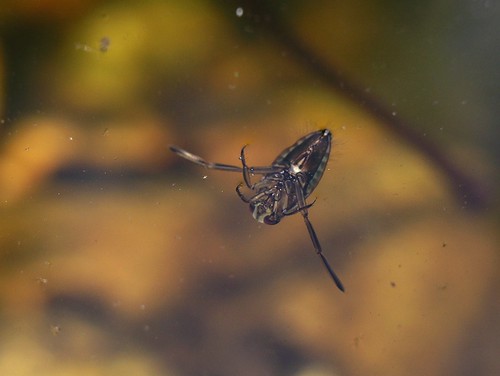
The last few delicate mayflies are struggling from their nymph skins at the surface of the water, and most are managing to fly free and mate rather than getting caught on the surface tension and becoming dinner for other water life.
The frogs are now adults, and I see them every day enjoying the cover of the duckweed and frogbit, basking in the sun-warmed water or on the partially submerged logs.
The best visitor recently was a huge female Broad-Bodied Chaser Dragonfly, who popped by for a few minutes to lay her eggs. I heard her before I saw her, because her wings made a very deep and loud buzzing noise that is distinctive to large dragonflies.
Unlike some other species who lay their eggs carefully on the plants under the water, these dragonflies lay by dipping their abdomen briefly in the water and wiggling the tip to shake the eggs loose. She was so fast I struggled to get a good photo, but I was thrilled to see her. I really hope the eggs survive.
The pond is, without question, the best thing I ever created. If you have a garden and love wildlife, build one! Mine shows it doesn't have to be huge to be a haven. If you build it, they will most definitely come!

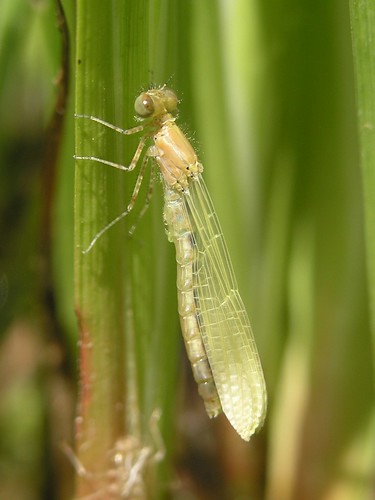


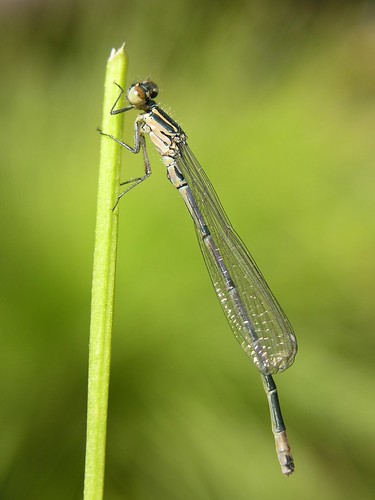





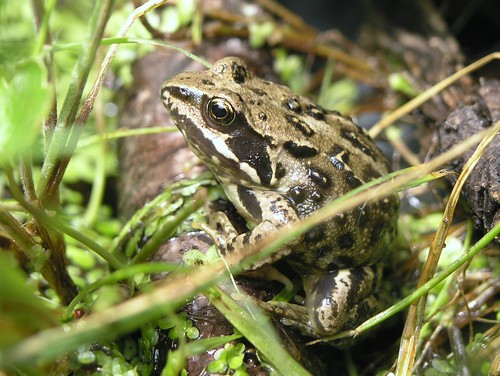
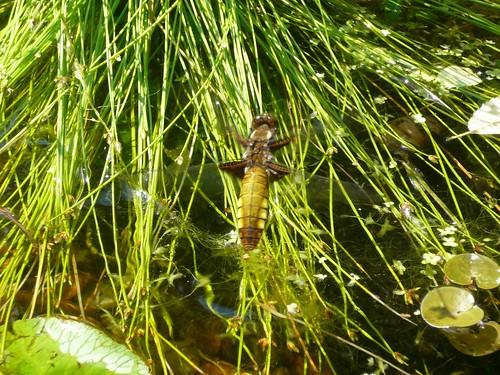
Hello there...so wonderful to have found you..a little mouse showed me the way..Your pictures are amazing!!!!!!!!!!!!! I made a link from my garden to yours..I hope this is ok with you..
ReplyDeleteGreets from Holand
The Dutchess and Company
http://thegardenoftheduchess.blogspot.com/
ReplyDeleteahhhhhhhhhhhhh.. Enchanting!
ReplyDeleteWhat a wonderful blog you have here (I've popped over from the Dutchess's place); you must have a great macro lens on your camera, to get such close shots!
ReplyDeleteWe love little things at our place, too, and I just posted a poem that could belong on yours: http://sweetefelicity.blogspot.com/2011/06/for-little-things.html
Love,
Marqueta